I won’t lie, watching the Maya Train being built over four years had me curious about how it would turn out. I mean, Mexico spent $30 billion USD—yes, billion with a “B”—on this project to promote tourism, connect popular destinations in the Mexican Caribbean, and boost economic development. But the route covers more than just the Riviera Maya. It stretches across five southern states of Mexico: from the crowning jewel of Mexican tourism, Quintana Roo on the east coast, through Yucatán, Campeche, and Tabasco, all the way to Chiapas on the west coast.
As soon as it was completed, I couldn’t wait to get on it. In fact, my excitement was so contagious that a friend flew down from Vermont to ride the rails with me and complete the entire 1,540 kilometers of the route.
From my home in Quintana Roo across Yucatán, Campeche, Tabasco, and into Chiapas—what a beautiful way to see southern Mexico. We climbed Maya ruins, floated through rapids, stood beside waterfalls in the rainforest with butterflies landing at our feet, and swam in the healing waters of the Lake of Seven Colors. We explored the golden city of Izamal and wandered through a Spanish colonial rainbow of historic districts by the Gulf of Mexico.
This trip had it all, and we managed to do it for under $200 a day. That includes hotels, transport, dining out for nearly every meal, cocktails, and of course, the occasional beer on the train. We were on holiday, after all.
So let me share our seven days of decadence on the new train.
Get Your Free Mexico Report Today!
Get Your Free Mexico Report Today!
Learn more about Mexico and other countries in our daily postcard e-letter. Simply enter your email address below and we’ll send you a free special report – Mexico: The Perfect Close-to-Home Retirement Haven.

By submitting your email address, you will receive a free subscription to IL Postcards, The Untourist Daily and special offers from International Living and our affiliates. You can unsubscribe at any time, and we encourage you to read more about our Privacy Policy.
Day 1: Cancun to Izamal

My friend flew into Cancun, so our journey began there. It was ideal because the Maya Train departs from Cancun four times a day, giving us flexibility. Plus, there’s a Maya Train bus that costs only 35 pesos, less than $2. I mention this because Cancun is renowned for taxi drivers overcharging. They tried to get us to go with them for 500 pesos ($25). So don’t ever feel pressured to take a taxi—the bus is brand new, cheap, comfortable, and a tenth of the price.
We grabbed our tickets to the golden magic town of Izamal. The price was $45, which is the international tourist fare. Even as a permanent resident of Mexico, I still had to pay it. Mexican citizens, retirees, and students get a discount, as is the case with many things here.
For four hours, we glided through jungle, then more open farmland. Crossing into Yucatán state was like entering Mother Nature’s palette. The iconic white limestone roads turned delicate shades of orange and pink in the setting sun, as if she’d brushed the landscape with watercolor.
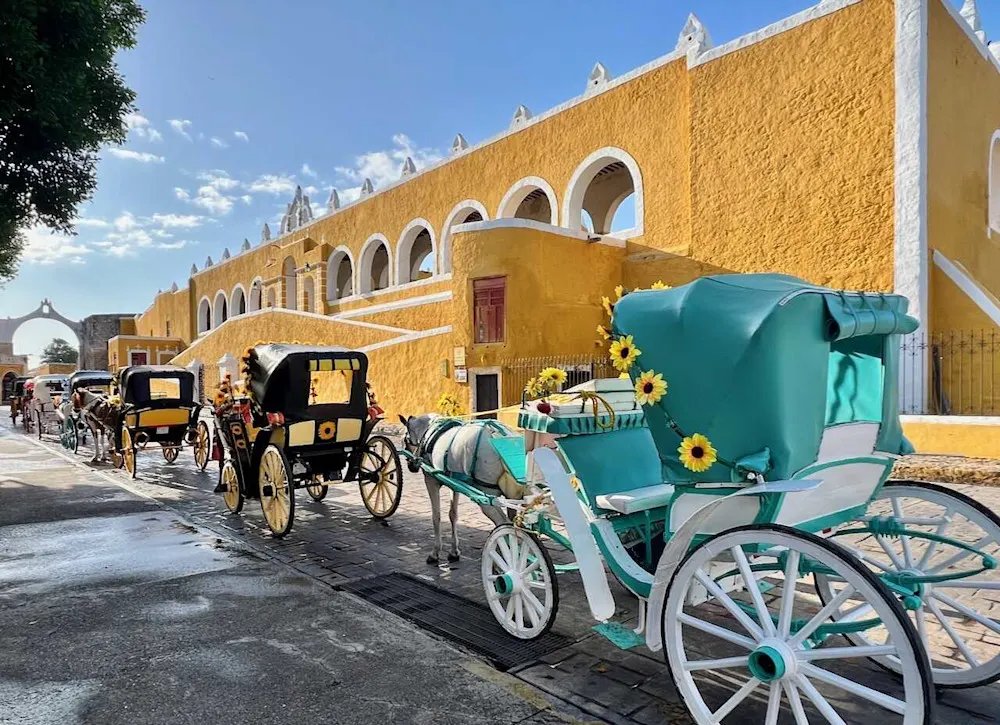
Arriving in Izamal, our first of three Pueblos Mágicos (magic towns) for the trip, my friend gasped. Its golden streets, all trimmed in white, glowed in the twilight. Our boutique hotel, San Miguel Arcangel, right on the town square, was gorgeous and peacefully quiet. And a bargain at $43 for the night, with breakfast included beside the courtyard fountain.
The next morning, we spent time exploring Izamal. Horse-drawn carriages clip-clopped along the cobbled streets.
Friendly locals greeted us with warm buenos días, and we grabbed a half-liter of fresh-squeezed juice for just two dollars in the town square. This is a small town full of smiling locals rather than tourists—amazing food, great markets, and fantastic value for money. Those golden streets are a dream for photographers, so don’t forget your camera.
You can walk around the town in just a couple of hours. Right on time, our friendly taxi driver from the night before arrived to take us back to the station.
Next stop: the beautiful seaside city of Campeche, nestled on the Gulf of Mexico.
Day 2: Izamal to Campeche

Tip: If you don’t speak Spanish, don’t worry. The station managers and some of the cashiers do speak English and can help you buy tickets. To make the process smoother, write your email address and phone number on a piece of paper to hand over each time you purchase a ticket.
The three-hour train ride from Izamal, Yucatán, to Campeche City, nestled on the Gulf of Mexico in Campeche state, costs $42. A Maya Train bus for the 20-minute ride into town was 50 pesos (about $2.50). Conveniently, it dropped us in Centro, just a five-minute walk from our stunning historic four-star hotel, Castelmar Hotel.
I must say, Campeche is excellent value for money. Our beautiful Spanish colonial hotel was incredibly affordable at just $60. For dinner, we chose an Italian restaurant in the elegant historic center district. We each enjoyed a personalized pizza and shared a bottle of delicious Spanish red wine—all for $55.
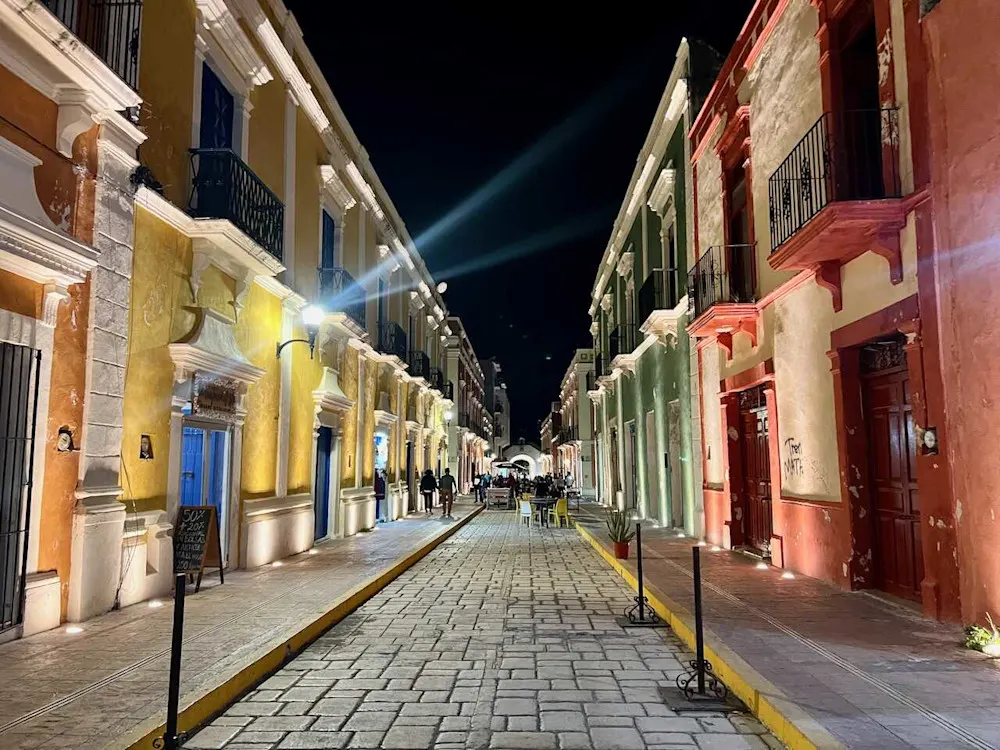
Breakfast the next morning was just as impressive. Freshly ground hot cacao coffee, prepared tableside, came with fresh-squeezed juices and generous portions for just $25.
Huge rain trees shaded the parks, surrounded by buildings painted in every color of the rainbow. The architecture alone had us stopping for photos on nearly every block. And the waterfront features a wide malecón perfect for walking, cycling, or jogging along the Gulf of Mexico.
It was my first time in Campeche, and I was impressed. But as great as the stay was, I couldn’t wait to reach our second Pueblo Mágico and next stop: Palenque.
Day 3–5: Campeche to Palenque
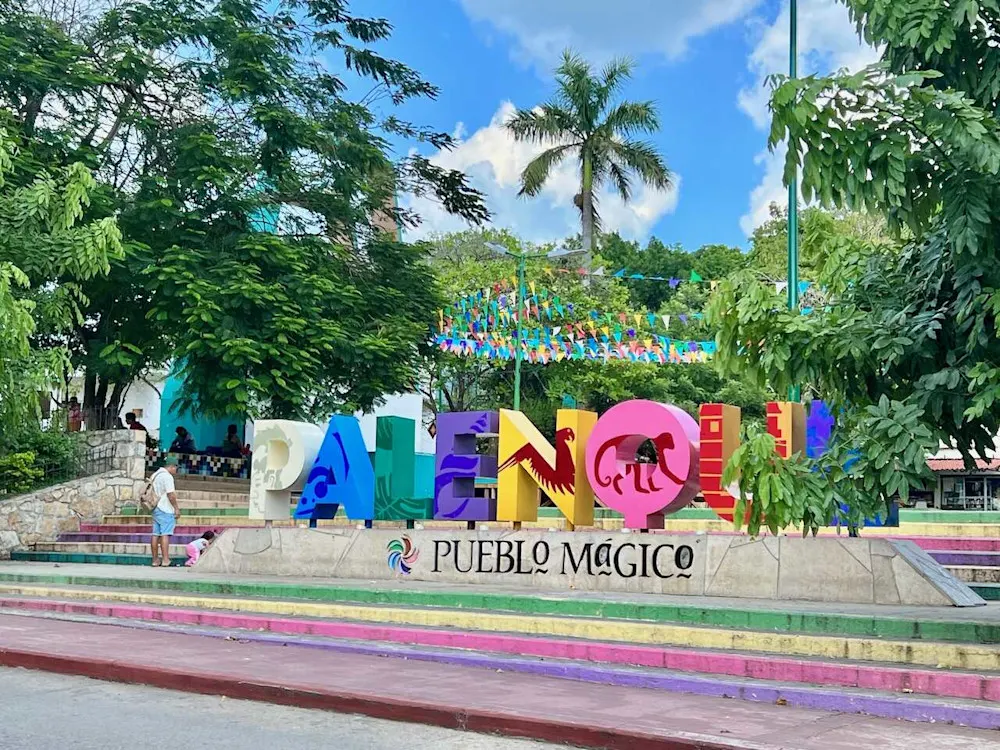
Palenque is a Pueblo Mágico famous for its massive UNESCO World Heritage Mayan ruins and stunning natural beauty.
A four-and-a-half-hour train ride away, we left the cool blues of Campeche’s seaside for the lush greens and towering trees of Palenque’s rainforest. Crossing three states—Campeche, Tabasco, and Chiapas—the train ticket cost $66.
Palenque is also known for its friendly locals, and our ten-minute drive into town was made even more pleasant by a chatty, cheerful driver. Casa 5 Bed & Breakfast was another excellent and surprisingly luxurious stay. We had a king-sized bed, breakfast included, and a location right in the center of town—all for just $53 a night. It ended up being our favorite stay of the trip.
The Mayan ruins are about five minutes outside of town. For $10, you can get admission to both the ruins and the national park. I wanted to learn everything I could about the site, so we hired a guide, Cha’at, at the entrance for $40.

We spent the day climbing ruins and exploring ancient tombs. Towering trees, draped in bromeliads with red and yellow flowers, shaded the paths. It’s paradise. Bright orange Pale Daggerwing butterflies landed at our feet as we stood by rainforest streams, admiring blue-tailed skinks darting over mossy rocks. The biodiversity here is astounding. I’ll definitely be returning to Palenque to explore more.
But it was time to say goodbye to our second Pueblo Mágico and head to our third: Bacalar. A magic town famous for its Lake of Seven Colors and healing waters.
Bye-bye, emerald rainforest… hello, beautiful blue lake.
Get Your Free Mexico Report Today!
Get Your Free Mexico Report Today!
Learn more about Mexico and other countries in our daily postcard e-letter. Simply enter your email address below and we’ll send you a free special report – Mexico: The Perfect Close-to-Home Retirement Haven.

By submitting your email address, you will receive a free subscription to IL Postcards, The Untourist Daily and special offers from International Living and our affiliates. You can unsubscribe at any time, and we encourage you to read more about our Privacy Policy.
Day 5–7: Palenque to Bacalar
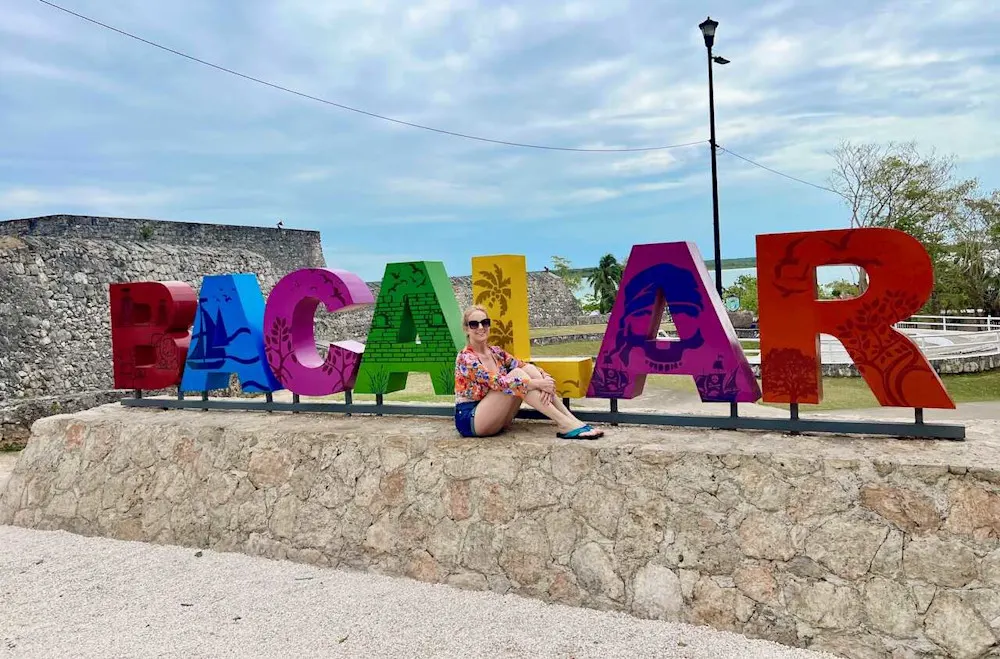
This was our longest stretch on the train—eight hours riding the rails from Chiapas in the west, across five southern Mexican states, to Bacalar on the east coast in my home state of Quintana Roo.
The train is so smooth, I was able to sketch in my travel journal in pen—no smudges or slips. That’s saying something about the engineering!
Bacalar, the third and final Pueblo Mágico of our trip, is one of my favorite places in Mexico. Nestled beside a lake, locals call it a lagoon, the water shifts in color from pale sky blue to deep sapphire, with stunning hues of turquoise, azure, cobalt, and cerulean in between. These waters practically beg you to dive in, and the Maya believe they’re healing. I agree.
They’re also home to one of our planet’s oldest living organisms: stromatolites. These ancient formations are most concentrated at Los Rápidos, about twenty minutes from town.
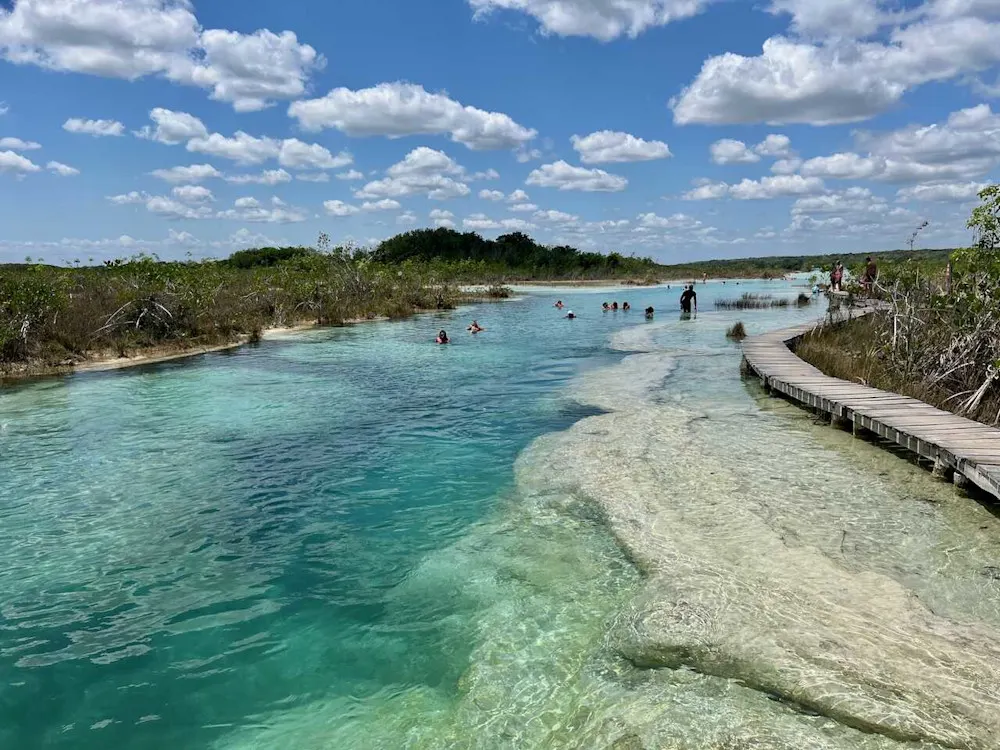
Now, don’t be fooled by the name; there are no rapids. It’s a gentle float through the formations, and truly one of the most incredible places I’ve ever been.
Entry costs $10, and the taxi ride from town is the same. There’s a restaurant on-site, so you can enjoy lunch out there, but plan to go early, as it fills up fast.
The rest of our time in Bacalar was spent dining on the waterfront, sipping cocktails by the pool, and eating ice cream. The best mint chip I’ve ever tasted was at the ice cream shop on the town square.
We were so relaxed that we never wanted to leave, but it was time to head home. Our last night would be spent in Playa del Carmen.
Day 7: Bacalar to Playa del Carmen
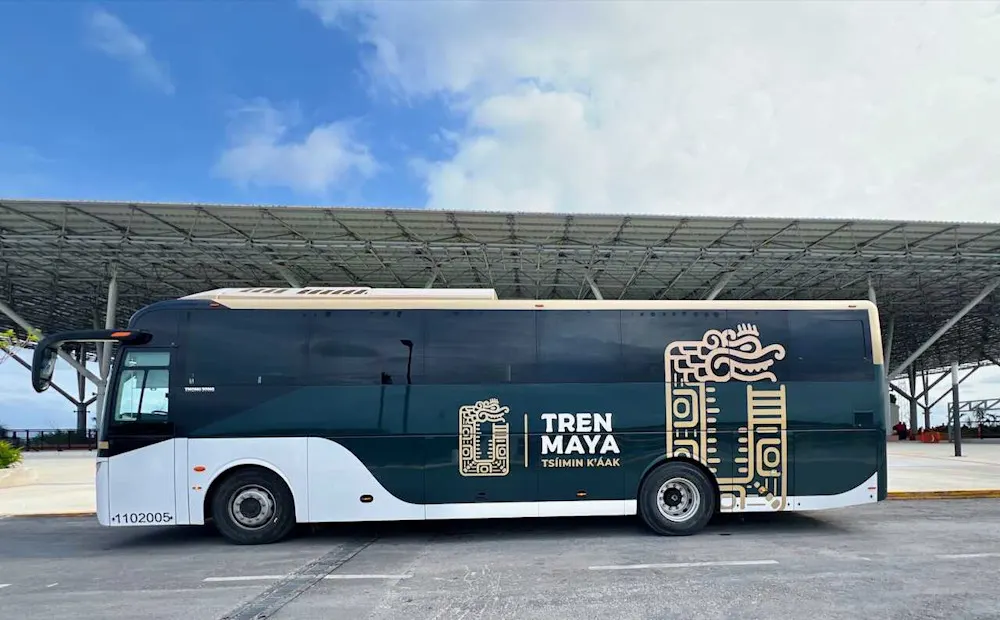
The Maya Train leaves Bacalar only twice a day, and it can sell out. Book early—through the app, website, or at the station—or you might end up on the bus. Luckily, the ADO buses run about every 30 minutes, and at $28, they’re far more affordable than the $80 train fare.
We spent our final night at Meliora in Playa del Carmen, enjoying our own apartment, an ideal way to end our cross-country adventure. Over breakfast the next day, we reminisced about the journey before parting ways. My friend caught the bus to Cancun International Airport, and I hopped on the ferry back to Cozumel.
What a week, and what a wonderful way to see five states, three magic towns, and make lifelong memories with a dear friend.
Get Your Free Mexico Report Today!
Get Your Free Mexico Report Today!
Learn more about Mexico and other countries in our daily postcard e-letter. Simply enter your email address below and we’ll send you a free special report – Mexico: The Perfect Close-to-Home Retirement Haven.

By submitting your email address, you will receive a free subscription to IL Postcards, The Untourist Daily and special offers from International Living and our affiliates. You can unsubscribe at any time, and we encourage you to read more about our Privacy Policy.
